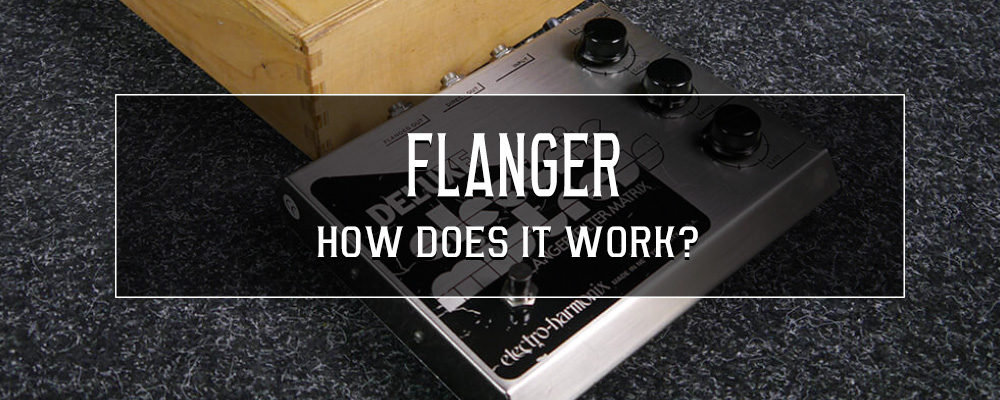
Following on from last weeks blog piece about “How Does A Chorus Work?”, I’m going to dive head first into one of my favourite modulation effects, the humble Flanger Pedal.
Before we start…
Fun Fact 1: My first pedal, that I bought out of my own money (the others I had used before this I had begged, borrowed or stol… had gifted to me) was a vintage Flanger Pedal – the legendary Electric Mistress Deluxe.
Fun Fact 2: The first pedal I threw straight into the bin (about a year later) was the aforementioned Flanger Pedal, the Deluxe Electric Mistress, because it had stopped working… this was LONG before the days of the internet providing schematics etc and I couldn’t find anyone to repair it. Yes, I am horrified by this!!
As with the chorus blog, please do not expect the effect I create to compare to your favourite Flanger Pedal, because the variables that occur in flangers are far more comprehensive than what I am going to demonstrate here, but this will show you the mechanics of how the effect works at the most basic level, and you’ll be able to see it all happening on the video examples. As it’s a Flanger, and I’m on a Gilmour trip at the moment, I’m playing “Us And Them” from Dark Side Of The Moon, because the original has an epic Flanger on it, the legendary Electric Mistress by EHX, and of course, I will take any excuse available to play a little bit of one of the greatest guitar players to walk the earth.
The guitar used on this is my workhorse PRS Brent Mason signature, straight into the soundcard, with no other effects applied. The same line (file) is used throughout so there are no inconsistencies between any of them (apart from those within my own playing!).
Primarily, a Flanger works by adding a slight delay to a replicated signal along an LFO (low frequency oscillation) but this time the wave is not a smooth sine wave, but a nice pointy one. There are two primary things happening when you hear a Flanger effect, and those are the delay time and the amount of feedback of that delayed time.
Delay Time
In this example, the delay time is being moved from 1ms to 5ms. You can follow the line and see it moving along the automation line to the points, and also on the excellent Soundhack plugin underneath. In this example the Flanged line is sounding along with the dry unaffected track above it. To increase the “Rate” of the Flanger, you would make the sweep between the low and high points shorter, or if you want to think about it in a visual way, push the peaks closer together.
Feedback.
This was the one that surprised me the most when recreating this, because the feedback (just like the regular feedback – or ‘repeats’ – control on your delay pedal) is set really high in order to make it work. This is often labelled as “Intensity”, or like the Terraform, “Depth”. The most you will get before it starts to get really silly and feedback on itself making a truly horrific noise is about 88%. In this example the delay is going between 1ms – 5ms again, but the feedback increases slowly from about 40% and tops out at about 80%. For this example, I’ve removed the original line so you can hear the effect better. You start to hear that very familiar deep Flanger sound at around 70%.
Negative Feedback.
One of my favourite Flanger tones is when it has a negative Feedback to it, now… this is oversimplifying it MASSIVELY, but… by creating a second duplicate line with the phase inverted, kinda gets you close enough to get the idea! Like I said, this is only a representation, but not really how it works in reality.
A Stereo Flanger.
This time I’ve duplicated the Flanger line, panned them hard left and right, and put the waves on a slightly different pattern to give that separation we all know and love – as you can see, there are two waves on the screen, and you can follow each one as you are listening. For no reason other than to experiment, I set the feedback of the right channel lower than the left, so if you concentrate, you will hear the different as they are moving. Please listen through headphones!
Stereo Flanger – one side inverted.
Because, “why not”, I took the same process as above and inverted the phase on one side, it’s subtle, but really cool! Once again, you really should listen to this through headphones to get the full effect.
How does it sound?
So, how does my homemade Flanger stand up in the real world? I expect I am like MANY people around the world (following the recent death of Neil Peart) are currently bingeing on Rush. I found the stems to a live version of Rush’s genius “Spirit Of The Radio” and removed Alex Lifeson from the mix (blasphemy), rerecorded his parts (blasphemy) and mixed it in with the rest of the band (blasphemy). I replicated his tone as close as I could to the version I was playing along to (please don’t compare it to the original studio version) – if you look closely you’ll notice I remove the Flanger line completely (the highlighted strip, Audio 4) right before the first verse, and then bring it back in again once Geddy starts singing.
In order to make this work, I had to do a few Logix routing shenanigans… I recorded the line direct, I duplicated it, the Flanger was place on the second one, both were then fed into a sub group where they were put straight in to the front of a screaming SLO100, on the drive channel (because, why not?). What do you think? It’s not the best Flanger in the world by any stretch of the imagination but you can see it working and making a noise similar to the effect we all know and love!



I do not even know howw I ended up here, but I thought
this pos was great. I don’t know who yyou are but definitely
you are going to a famous blogger if you are not already ;
) Cheers!
Thank you!